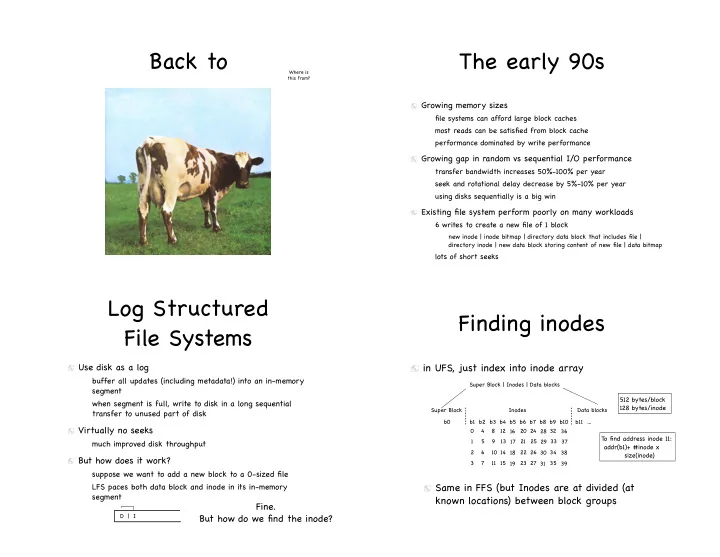

Back to The early 90s Where is this from? Growing memory sizes file systems can afford large block caches most reads can be satisfied from block cache performance dominated by write performance Growing gap in random vs sequential I/O performance transfer bandwidth increases 50%-100% per year seek and rotational delay decrease by 5%-10% per year using disks sequentially is a big win Existing file system perform poorly on many workloads 6 writes to create a new file of 1 block new inode | inode bitmap | directory data block that includes file | directory inode | new data block storing content of new file | data bitmap lots of short seeks Log Structured Finding inodes File Systems Use disk as a log in UFS, just index into inode array buffer all updates (including metadata!) into an in-memory Super Block | Inodes | Data blocks segment 512 bytes/block when segment is full, write to disk in a long sequential 128 bytes/inode Super Block Inodes Data blocks transfer to unused part of disk b0 b1 b2 b3 b4 b5 b6 b7 b8 b9 b10 b11 ... Virtually no seeks 0 4 8 12 20 24 32 16 28 36 To find address inode 11: 1 5 9 13 17 21 25 29 33 37 much improved disk throughput addr(b1)+ #inode x 2 6 10 14 18 22 26 30 34 38 size(inode) But how does it work? 3 7 11 15 19 23 27 31 35 39 suppose we want to add a new block to a 0-sized file LFS paces both data block and inode in its in-memory Same in FFS (but Inodes are at divided (at segment known locations) between block groups Fine. D | I But how do we find the inode?
Finding inodes in LFS LFS vs UFS inode Inode map: a table indicating where each inode is on disk file1 file2 directory Inode map blocks are written as part of the segment data ... so need not seek to write to imap dir2 dir1 Unix File System but how do we find the blocks of the Inode map? inode map dir1 dir2 Normally, Inode map cached in memory Log On disk, found in a fixed checkpoint region Blocks written to updated periodically (every 30 seconds) file2 create two 1-block files: file1 dir1/file1 and dir2/file2 Log-structured File System The disk then looks like in UFS and LFS CR seg1 free seg2 seg3 free Reading from disk in LFS Garbage collection Suppose nothing in memory... As old blocks of files are replaced by new, segment in log become fragmented read checkpoint region Cleaning used to produce contiguous space on which to write from it, read and cache entire inode map compact M fragmented segments into N new segments, newly from now on, everything as usual written to the log read inode free old M segments use inode’ s pointers to get to data blocks Cleaning mechanism: When the imap is cached, LFS reads involve How can LFS tell which segment blocks are live and which dead? virtually the same work as reads in traditional file Segment Summary Block systems modulo an Cleaning policy imap lookup How often should the cleaner run? How should the cleaner pick segments?
Which segments to Segment Summary Block clean, and when? Kept at the beginning of each segment When? For each data block in segment, SSB holds when disk is full periodically The file the data block belongs to (inode#) The offset (block#) of the data block within the file when you have nothing better to do During cleaning, to determine whether data block D is live: Which segments? use inode# to find in imap where inode is currently on disk utilization: how much it is gained by cleaning read inode (if not already in memory) segment usage table tracks how much live data in segment check whether a pointer for block block# refers to D’ s address age: how likely is the segment to change soon Update file’ s inode with correct pointer if D is live and better to wait on cleaning a hot block, since free blocks are going to quickly reaccumulate compacted to new segment Crash recovery The journal is the file system! On recovery read checkpoint region may be out of date (written periodically) may be corrupted 1) two CR blocks at opposite ends of disk / 2) timestamp blocks before and after CR use CR with latest consistent timestamp blocks roll forward start from where checkpoint says log ends read through next segments to find valid updates not recorded in checkpoint when a new inode is found, update imap when a data block is found that belongs to no inode, ignore
Recommend
More recommend